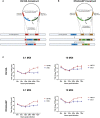Protective Efficacy of an Orf Virus-Vector Encoding the Hemagglutinin and the Nucleoprotein of Influenza A Virus in Swine
- PMID: 34804030
- PMCID: PMC8602839
- DOI: 10.3389/fimmu.2021.747574
Protective Efficacy of an Orf Virus-Vector Encoding the Hemagglutinin and the Nucleoprotein of Influenza A Virus in Swine
Abstract
Swine influenza is a highly contagious respiratory disease of pigs caused by influenza A viruses (IAV-S). IAV-S causes significant economic losses to the swine industry and poses challenges to public health given its zoonotic potential. Thus effective IAV-S vaccines are needed and highly desirable and would benefit both animal and human health. Here, we developed two recombinant orf viruses, expressing the hemagglutinin (HA) gene (OV-HA) or the HA and the nucleoprotein (NP) genes of IAV-S (OV-HA-NP). The immunogenicity and protective efficacy of these two recombinant viruses were evaluated in pigs. Both OV-HA and OV-HA-NP recombinants elicited robust virus neutralizing antibody response in pigs, with higher levels of neutralizing antibodies (NA) being detected in OV-HA-NP-immunized animals pre-challenge infection. Although both recombinant viruses elicited IAV-S-specific T-cell responses, the frequency of IAV-S-specific proliferating CD8+ T cells upon re-stimulation was higher in OV-HA-NP-immunized animals than in the OV-HA group. Importantly, IgG1/IgG2 isotype ELISAs revealed that immunization with OV-HA induced Th2-biased immune responses, whereas immunization with OV-HA-NP virus resulted in a Th1-biased immune response. While pigs immunized with either OV-HA or OV-HA-NP were protected when compared to non-immunized controls, immunization with OV-HA-NP resulted in incremental protection against challenge infection as evidenced by a reduced secondary antibody response (NA and HI antibodies) following IAV-S challenge and reduced virus shedding in nasal secretions (lower viral RNA loads and frequency of animals shedding viral RNA and infectious virus), when compared to animals in the OV-HA group. Interestingly, broader cross neutralization activity was also observed in serum of OV-HA-NP-immunized animals against a panel of contemporary IAV-S isolates representing the major genetic clades circulating in swine. This study demonstrates the potential of ORFV-based vector for control of swine influenza virus in swine.
Keywords: cell-mediated immunity; neutralizing antibodies; orf virus; swine influenza virus; vectored-vaccine.
Copyright © 2021 Joshi, Knudsen, Piñeyro, Dhakal, Renukaradhya and Diel.
Conflict of interest statement
DD has patent on orf virus vector (patent no. 11013798). The remaining authors declare that the research was conducted in the absence of any commercial or financial relationships that could be construed as a potential conflict of interest.
Figures







References
-
- USDA . Influenza A Virus in Swine Surveillance. United States Department of Agriculture; (2020). Accessed from: https://www.aphis.usda.gov/animal_health/animal_dis_spec/swine/downloads....
-
- OIE . Swine Influenza. World Organization for Animal Health; (2019). Accessed from: https://www.oie.int/app/uploads/2021/03/swine-influenza.pdf.
Publication types
MeSH terms
Substances
LinkOut - more resources
Full Text Sources
Other Literature Sources
Medical
Research Materials
Miscellaneous

